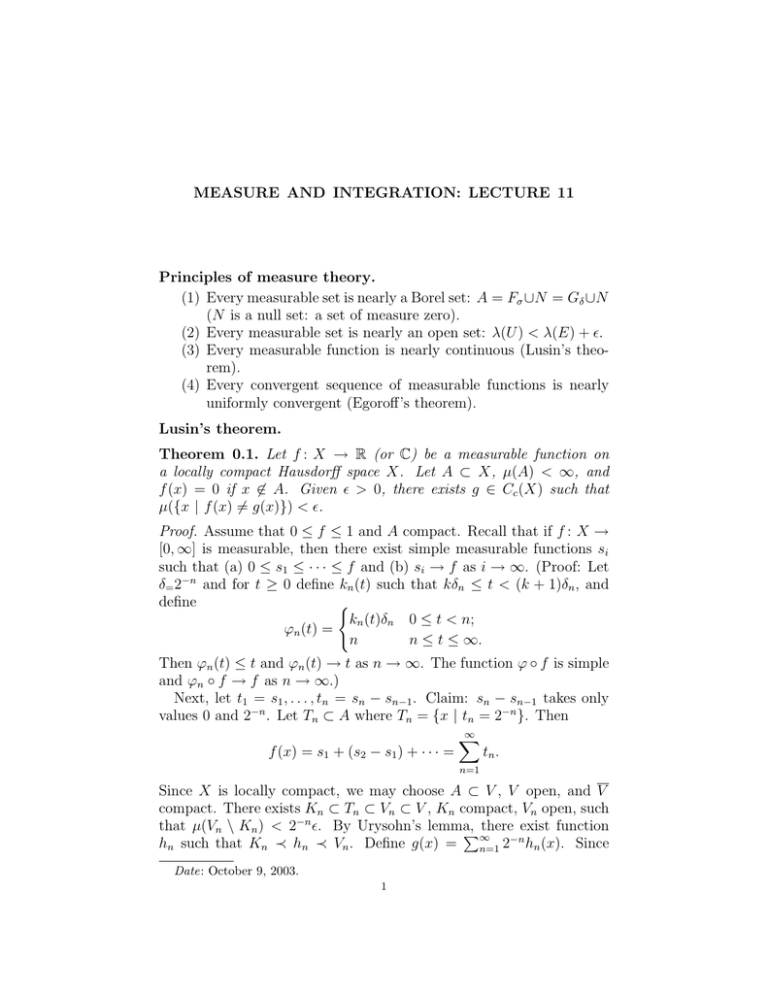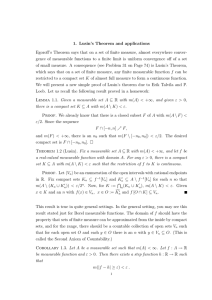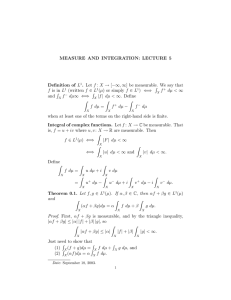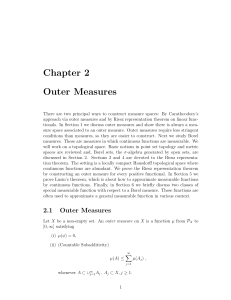Document 13570263
advertisement

MEASURE AND INTEGRATION: LECTURE 11
Principles of measure theory.
(1) Every measurable set is nearly a Borel set: A = Fσ ∪N = Gδ ∪N
(N is a null set: a set of measure zero).
(2) Every measurable set is nearly an open set: λ(U ) < λ(E) + �.
(3) Every measurable function is nearly continuous (Lusin’s theo­
rem).
(4) Every convergent sequence of measurable functions is nearly
uniformly convergent (Egoroff’s theorem).
Lusin’s theorem.
Theorem 0.1. Let f : X → R (or C) be a measurable function on
a locally compact Hausdorff space X. Let A ⊂ X, µ(A) < ∞, and
f (x) = 0 if x �∈ A. Given � > 0, there exists g ∈ Cc (X) such that
� g(x)}) < �.
µ({x | f (x) =
Proof. Assume that 0 ≤ f ≤ 1 and A compact. Recall that if f : X →
[0, ∞] is measurable, then there exist simple measurable functions si
such that (a) 0 ≤ s1 ≤ · · · ≤ f and (b) si → f as i → ∞. (Proof: Let
δ= 2−n and for t ≥ 0 define kn (t) such that kδn ≤ t < (k + 1)δn , and
define
�
kn (t)δn 0 ≤ t < n;
ϕn (t) =
n
n ≤ t ≤ ∞.
Then ϕn (t) ≤ t and ϕn (t) → t as n → ∞. The function ϕ ◦ f is simple
and ϕn ◦ f → f as n → ∞.)
Next, let t1 = s1 , . . . , tn = sn − sn−1 . Claim: sn − sn−1 takes only
values 0 and 2−n . Let Tn ⊂ A where Tn = {x | tn = 2−n }. Then
∞
�
f (x) = s1 + (s2 − s1 ) + · · · =
tn .
n=1
Since X is locally compact, we may choose A ⊂ V , V open, and V
compact. There exists Kn ⊂ Tn ⊂ Vn ⊂ V , Kn compact, Vn open, such
there exist function
that µ(Vn \ Kn ) < 2−n �. By Urysohn’s lemma,
�∞
hn such that Kn � hn � Vn . Define g(x) = n=1 2−n hn (x). Since
Date: October 9, 2003.
1
2
MEASURE AND INTEGRATION: LECTURE 11
this series converges uniformly on X, g is continuous and supp f ⊂ V .
f (x) except on
But 2−n hn (X) = tn except on Vn \ Kn . Thus, g(x) = �
∞
n
∪∞
V
\
K
,
and
µ
of
this
set
is
less
than
or
equal
to
n
n=1 n
n=1 �/2 = �.
Thus, we have proved the case where 0 ≤ f ≤ 1 and A is compact.
Thus, it is true when f is a bounded measurable function and A is
compact.
Now look at
f
f=
.
(sup f ) + 1
If A is not compact and µ(A) < ∞, then there exists K ⊂ A such that
µ(A \ K) < � for any �. Let g = 0 on A \ K. For f not bounded, let
Bn = {x | |f (x)| > n}. Then ∩n Bn = ∅, so µ(Bn ) → 0. Then f agrees
with (1 − χBn )f except on Bn , and we can let g = 0 on Bn .
�
Corollary 0.2. Let f : X → R, A ⊂ X, µ(A) < ∞, f (x) = 0 if
x �∈ A, and |f (x)| < M for some M < ∞. Then there exists a sequence
gn ∈ Cc (X) such that |gn (x)| < M and f (x) = limn→∞ gn (x) almost
everywhere.
Proof. By the theorem, for n > 0, there exists gn ∈ Cc (X) such that
−n
. Let En = {x | f �= gn }. Then
sup |gn | ≤ sup |f | < M�and µ(En ) < 2�
∞
∞
En is measurable and n=1 µ(En ) = n=1 2−n < ∞. Claim:
� almost all
x ∈ X lie in at most finitely many Ek . Proof: Let g(x) = ∞
k=1 χEk (x).
Then x is in infinitely many Ek ⇐⇒ g(x) = ∞. We have
�
∞ �
�
g(x) dµ =
χEk (x) dµ < ∞
X
k=1
X
by monotone convergence. Thus, g(x) < ∞ almost everywhere, which
�
implies that lim gn = f a.e.
Vitali­Caratheodory theorem.
Theorem 0.3. Let f : X → R and f ∈ L1 (µ). Given � > 0, there exists
functions u, v : X → R such that�u ≤ f ≤ v, u is upper semicontinuous,
v is lower semicontinuous, and (v − u)dµ < �.
Proof. Assume f ≥ 0. Choose 0 ≤ s1 ≤ · · · ≤ f simple and measurable
sn − sn−1 . Then tn has only finitely
such that lim sn = f . �Let tn = �
∞
many values and f = ∞
t
=
n
k=1
k=1 ck χEk . We have
�
∞
�
ci µ(Ei ) < ∞.
f dµ =
X
i=1
MEASURE AND INTEGRATION: LECTURE 11
3
Choose Ki ⊂ Ei ⊂ Vi , Ki compact, Vi open, such that ci µ(Vi \ Ki ) <
2−i−1 �. Let
∞
N
�
�
v=
ci χVi , u =
ci χKi ,
i=1
i=1
�
where N is chosen so that ∞
c
µ(E
)
i < �/2. Then v is lower semi­
N +1 i
continuous, u is upper semicontinuous, and u ≤ f ≤ v. Also,
N
�
v−u=
≤
≤
i=1
∞
�
ci (χVi − χKi ) +
ci (χVi − χKi ) +
i=1
∞
�
∞
�
ci χVi
N +1
∞
�
ci (χVi − χVi + χKi )
i=N +1
ci χKi ,
i=N +1
and so
�
(v − u)dµ ≤
X
∞
�
ci µ(Vi \ Ki ) +
i=1
∞
�
ci χEi
N +1
< �/2 + �/2 = �.
�




